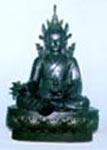Metal Statues
Nepali Copper Statues - or "Rupas" as they are known to the Newari and to their Tibetan customers of many many centuries. These statues have been sought after world-over for their craftsmanship, where generations upon generations of Nepalese still produce these treasures using the "lost wax" process of their ancestors. Hand carved and hand-painted, these statues are representative of the thousands of Gods worshiped by Hindus and Buddhists alike, and are still made today as they were centuries ago. Please also see History below, as in addition to the statues listed, we have access to any historical figure imaginable.
click on images for more detail
 ITEM RUP001
ITEM RUP001
Classic copper statue (xxxxx God) approx. 15 cm high, with gold plate and gold painting of the face.
Special Web Price: $80 USD (inclusive of S&H world-wide)
 Again, we have almost any Icon in stock or available for quick shipment, so just drop us a request! Prices vary and depend on detail of work, but at Namaste we have the best statues at about $10-15 USD per inch high. These prices are just the lowest in Nepal!
Again, we have almost any Icon in stock or available for quick shipment, so just drop us a request! Prices vary and depend on detail of work, but at Namaste we have the best statues at about $10-15 USD per inch high. These prices are just the lowest in Nepal!
History of Statue Making in Nepal
The lost wax casting of metal icons
As the name denotes, the principal rule of this method of casting is preparing a wax model, covering it with varieties of clay, heating the piece so that the wax melts, extracting the liquid wax so that a cavity is created, pouring melted metal into the cavity, and cooling it so that the original wax model is translated into the metal image. But, unlike the simplicity of the rule, getting a perfect cast is a very complicated job. A lot of care is needed for preparing raw wax to the final stage of gilding. Roughly, the whole process of metal image making is:

- Initial wax casting - The bee wax is melted in a pot and shale powder is mixed with the bee wax so as to make it more tensile. The wax is molded into a rough shape by hand and all the parts of a body, ornaments etc. are gradually added. Thus, finally a wax model is ready.
- Cover the wax mold with mud - The wax mold is first dipped into a mixture of fine clay, rice bran and cowdung. Then the piece is dried in some airy space where there is no direct sunlight. The same process is repeated again. Then a paste of another type of fine clay, rice bran and cowdung is pasted onto the mold. Depending upon the size of the image, this process is repeated (after drying) two to three times.

- The lost wax process - The mold, covered with layers of mud, is heated under weak heat so that the wax inside melts. The melted wax is extracted through a hole. Thus a hollow space is created inside.
- Pouring of Metal - Melted metal is poured into the cavity created by the lost wax process and when it is cooled off, a metal image is created.
- Engraving - The metal image out of the casting is very rough. The surface has to be made smooth, chiselling is to be done to bring precision.
- Gilding - When the image is ready, gold or silver is gilded onto it. Mercury and pieces of gold/silver are mixed in such a proportion that the gold or silver is ready for gilding.
The Namaste Collection Pvt. Ltd.
"The Very Best of Nepalese Handicrafts"
|



